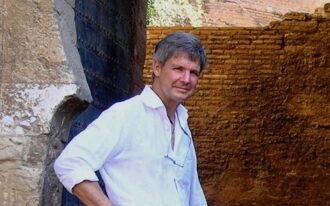 Venture capitalist, philanthropist, author and poet Steven Nightingale argues that Idries Shah’s works on Sufism have a transcendental value allied with their practical and daily usefulness.
Venture capitalist, philanthropist, author and poet Steven Nightingale argues that Idries Shah’s works on Sufism have a transcendental value allied with their practical and daily usefulness.
We must look at the world we have made: the crudity of our politics, the menace of military force, the threat of oblivion from atomic weapons; the destruction of earth’s life support systems, the fundamentalism that corrupts religious faith.
What resource we might turn to, if we are to confront with wisdom and sentience so lurid an array of challenges? We stand in the most urgent need of examining the texts we study—the ways of life offered us in language—in search of authentic understanding, of insight into the working of our minds and the redemptive dreams of our spirit.
There is no resource like a good book: one born of long study, beautifully conceived and mindfully composed, with the most potent mix of learning, intuition, and instruction. Where, among the welter of volumes, the annual cascade of prizes and promotions and citations, might we identify such volumes, ones that speak to the life of the times and to the life of each of us?
One of the foremost accomplishments of the last century
My own recommendation to everyone is the oeuvre of Idries Shah, whose collective work I hold to be one of the foremost accomplishments of the last century — perhaps of the last few centuries. Beginning in 1964 with his publication of the seminal work, The Sufis, and in the more than thirty books of stories and short essays that followed, Idries Shah set forth the literature, teaching, principles, and history of Sufism, adapted to the needs and qualities of our present day. The books, as they were published, earned worldwide interest and study, and were justly celebrated for their usefulness, intuitive configuration, and beauty. Sufism, as presented by Idries Shah, gives itself with grace and openheartedness, in a way that builds a bond of trust with the reader.
Idries Shah presents a tradition of life, thought, and study, and taken as a whole offers the reader an introduction to a way of life with ancient roots, centuries-long practice and refinement, and contemporary relevance. Some central facts are easily stated: the Sufis hold that the revelations of Islam, Christianity, and Judaism have a common source. Those original revelations were configured into their respective forms of worship, ritual, and belief according to the constraints of language, place, time, and historical circumstances. But the core experience — the radiant transformation of a man or woman by love, understanding, and study — remains a possibility, if we might seek to be worthy of such a birthright.

Another life is possible
In the technological, materialistic, and pessimistic era in which, especially in the West, we live currently, such a claim is likely to be dismissed out of hand. Allow me, therefore, to state it again, in different terms: each of us may be capable of a conscious evolution that gives rise to singular capacities of mind, and a prescient sense of the workings of the world and purposes of history. Such knowledge makes another life possible: one of potent intuition, generosity, and transcendental helpfulness. It is as if Sufism offers a way of love within history, because it is ready within the mind.
If any of this sounds fantastical, it is worth stating that such a description is meant, on the contrary, as plain fact. A modern smartphone would, not so long ago, have been seen as fantastical, But every such device works because of the verified science that underlies its functioning. We might think of Idries Shah’s work on Sufism as an initiatory course in the technology of the mind; it is as if he were presenting to us a science for comprehensive understanding. Look at the technologies now present and accepted: heart transplants, supercomputing, the modification of the genetic code, the design of machines meant to explore other planets in our solar system. Is it so outlandish to entertain the idea that in the course of human history, there might have been developed a science of the mind that has its own relevance and usefulness? And that, as with any of the fields that produced the breakthroughs mentioned, to learn such a science requires preparation, study in prescribed circumstances, knowledgeable oversight, and all the proper conditions of, as Idries Shah puts it, “right time, right place, right people”?
Now, the claim of having such a technology to offer raises from its ugly lair the spectacle of cults, some of which make analogous claims. Such cults have been present, it seems, always and everywhere, and may be identified by the way they enslave their adherents, and offer little more than emotional release and gratification, excitement about mysteries, and ordinary social fulfillments. The Sufis as a whole, and Idries Shah prominently, have stood firmly against such organized deception, however well-meaning such groups take themselves to be. Sufism is not about entertainment. It is about effectiveness.
Idries Shah and Sufism
Allow me to touch upon a few of the ideas in this field, which I pray the reader might take as a few drops thrown off from the clear stream of offerings in Idries Shah’s books. First, the notion of virtue among the Sufis: often, in our culture, the development of the virtues of, say, honesty, generosity, patience, humility, and so forth, is held to be an illustrious goal, and a person in possession of such virtues is valued accordingly. Among the Sufis to have such virtues represents the bare minimum of qualities necessary for useful study — baby steps that precede a fuller range of capacities that cannot be imagined beforehand. And as to the virtue of generosity, the Sufis do not tire of pointing out that material generosity is often a form of self-adornment, a fuel for self-esteem. Real generosity may occur when the giver is hardly conscious of giving at all—“the right hand does not know what the left hand is doing”—and the recipient thus does not know the giver, who remains anonymous.
And as to that clear stream of offerings: the teaching is of such variety, on so many levels, and addresses so many dimensions of mind, that it might be useful to have a saunter through some of the ideas and phrases in the work.
—The way ritual, doctrine, ceremony, and repetition put the mind to sleep.
—The incompleteness of the perceived world, which we take to be whole and finished.
—The way that people talking of any subject may be talking principally of themselves.
—The manner in which the essential nature of a person, no matter how well concealed, is inevitably shown forth.
—How we must in learning seek “the content, not the container; the wheat, not the measure in which it is contained; the meaning, not the man”.
—The need to move from belief to knowledge, from concept to experience. “He who tastes, knows.”
—The need to see into the world, and to live in the world, beyond obsession, attraction, desire, and appearance; to learn, that is, to be “in the world but not of it.”
—The presence in the world of invisible chains of cause and effect—in essence, a design—to which we may sensitize ourselves, so as to live life more fully.
—The way perfection “exists in a dimension other than its own; its local form leads us to it.”
—The reality of many forms of communication, including a direct bond of “heart to heart”.
—The need to study and work in a certain sequence, and not think of “making the bread before the flour is milled.”
—The need to seek “the truth for the sake of the truth, and not for the sake of ourselves.”
—The central importance of being able to distinguish the literal from the figurative, and the relative from the absolute.
—The way a teaching must work as an organic whole, which cannot be disassembled without destroying its function; no more than a bird can be disassembled, if we would have it live and fly.
—The need for deeply inclusive thinking, when we learn how to see an event or a problem from a host of different angles, putting together pieces and perspectives until we can see it whole.
—The means to set aside rigidity of mind, in favor of flexibility and suppleness of perception and action.
—The way jokes illuminate the working of the world and of our minds. Shah has introduced us to the brilliant world of Mulla Nasrudin. In hundreds of stories we read of a man of knowledge who teaches by the way he lives, and makes us laugh and learn not just about the world’s absurdities, but also about our own.
—The way a story can correspond to or evoke a deep structure in our minds, and, with time, reflection, and instruction, enrich our understanding and show us ways our work might be more beneficial to the human community.
Breaking our shackles
This last sentence brings me to the myriad stories themselves, now in circulation around the world. They are literature, and more than literature. Idries Shah never tired of pointing out that the stories, however beautiful, durable, or enveloping, are not valuable by reason of such qualities only. Rather, they have instrumental value. That is, they are valuable to life, to life itself: to our chances for understanding, for our attunement to objective reality. Surely, this claim is in concord with our own best hope to have in our hands books that have transcendental value, because they are so eminently practical.
Few of us can escape the sense that daily life is often enslaved to assumptions about appearance, to a deep pessimism and a persistent idolatry. In Idries Shah’s books we may find ways to break our shackles and learn to walk with a freedom that promises a way to peace.
Few of us can read the news in our era without the sense that misunderstanding and confusion poison our world. Yet we may with high confidence look for the antidote in the books of Idries Shah: they hold for us, and offer to us, a whole lucid work of love, clarity, and trustworthy counsel.
 Steven Nightingale is a venture capital investor, philanthropist, and the author of twelve books: two novels, six books of sonnets, and a long essay on the city of Granada, which has been translated for publication in Spain and India. His most recent books are The Hot Climate of Promises and Grace, sixty-four short stories about extraordinary women; and, co-authored with the Stanford scientist Richard Nevle, The Paradise Notebooks, a series of lyrical essays about the Sierra Nevada.
Steven Nightingale is a venture capital investor, philanthropist, and the author of twelve books: two novels, six books of sonnets, and a long essay on the city of Granada, which has been translated for publication in Spain and India. His most recent books are The Hot Climate of Promises and Grace, sixty-four short stories about extraordinary women; and, co-authored with the Stanford scientist Richard Nevle, The Paradise Notebooks, a series of lyrical essays about the Sierra Nevada.
